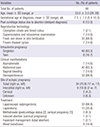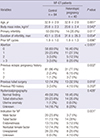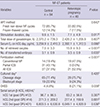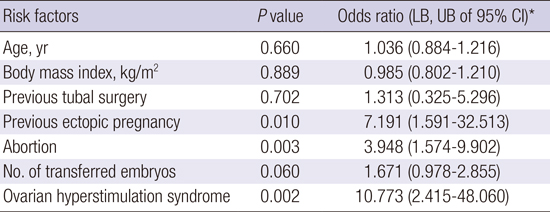1. Rizk B, Tan SL, Morcos S, Riddle A, Brinsden P, Mason BA, Edwards RG. Heterotopic pregnancies after in vitro fertilization and embryo transfer. Am J Obstet Gynecol. 1991; 164:161–164.
2. Dor J, Seidman DS, Levran D, Ben-Rafael Z, Ben-Shlomo I, Mashiach S. The incidence of combined intrauterine and extrauterine pregnancy after in vitro fertilization and embryo transfer. Fertil Steril. 1991; 55:833–834.
3. Marcus SF, Macnamee M, Brinsden P. Heterotopic pregnancies after in-vitro fertilization and embryo transfer. Hum Reprod. 1995; 10:1232–1236.
4. Marcus SF, Brinsden PR. Analysis of the incidence and risk factors associated with ectopic pregnancy following in-vitro fertilization and embryo transfer. Hum Reprod. 1995; 10:199–203.
5. Clayton HB, Schieve LA, Peterson HB, Jamieson DJ, Reynolds MA, Wright VC. A comparison of heterotopic and intrauterine-only pregnancy outcomes after assisted reproductive technologies in the United States from 1999 to 2002. Fertil Steril. 2007; 87:303–309.
6. Soriano D, Shrim A, Seidman DS, Goldenberg M, Mashiach S, Oelsner G. Diagnosis and treatment of heterotopic pregnancy compared with ectopic pregnancy. J Am Assoc Gynecol Laparosc. 2002; 9:353–358.
7. Luo X, Lim CE, Huang C, Wu J, Wong WS, Cheng NC. Heterotopic pregnancy following in vitro fertilization and embryo transfer: 12 cases report. Arch Gynecol Obstet. 2009; 280:325–329.
8. Shah Y, Zevallos H, Moody L. Combined intra- and extrauterine pregnancy. A diagnostic challenge. J Reprod Med. 1980; 25:290–292.
9. Dimitry ES, Subak-Sharpe R, Mills M, Margara R, Winston R. Nine cases of heterotopic pregnancies in 4 years of in vitro fertilization. Fertil Steril. 1990; 53:107–110.
10. Tummon IS, Whitmore NA, Daniel SA, Nisker JA, Yuzpe AA. Transferring more embryos increases risk of heterotopic pregnancy. Fertil Steril. 1994; 61:1065–1067.
11. Verhulst G, Camus M, Bollen N, Van Steirteghem A, Devroey P. Analysis of the risk factors with regard to the occurrence of ectopic pregnancy after medically assisted procreation. Hum Reprod. 1993; 8:1284–1287.
12. Reece EA, Petrie RH, Sirmans MF, Finster M, Todd WD. Combined intrauterine and extrauterine gestations: a review. Am J Obstet Gynecol. 1983; 146:323–330.
13. Buckett WM, Chian RC, Dean NL, Sylvestre C, Holzer HE, Tan SL. Pregnancy loss in pregnancies conceived after in vitro oocyte maturation, conventional in vitro fertilization, and intracytoplasmic sperm injection. Fertil Steril. 2008; 90:546–550.
14. Barlow P, Lejeune B, Puissant F, Englert Y, Van Rysselberge M, Degueldre M, Vekemans M, Leroy F. Early pregnancy loss and obstetrical risk after in-vitro fertilization and embryo replacement. Hum Reprod. 1988; 3:671–675.
15. Soriano D, Vicus D, Schonman R, Mashiach R, Shashar-Levkovitz D, Schiff E, Seidman DS, Goldenberg M. Long-term outcome after laparoscopic treatment of heterotopic pregnancy: 19 cases. J Minim Invasive Gynecol. 2010; 17:321–324.










 PDF
PDF ePub
ePub Citation
Citation Print
Print




 XML Download
XML Download